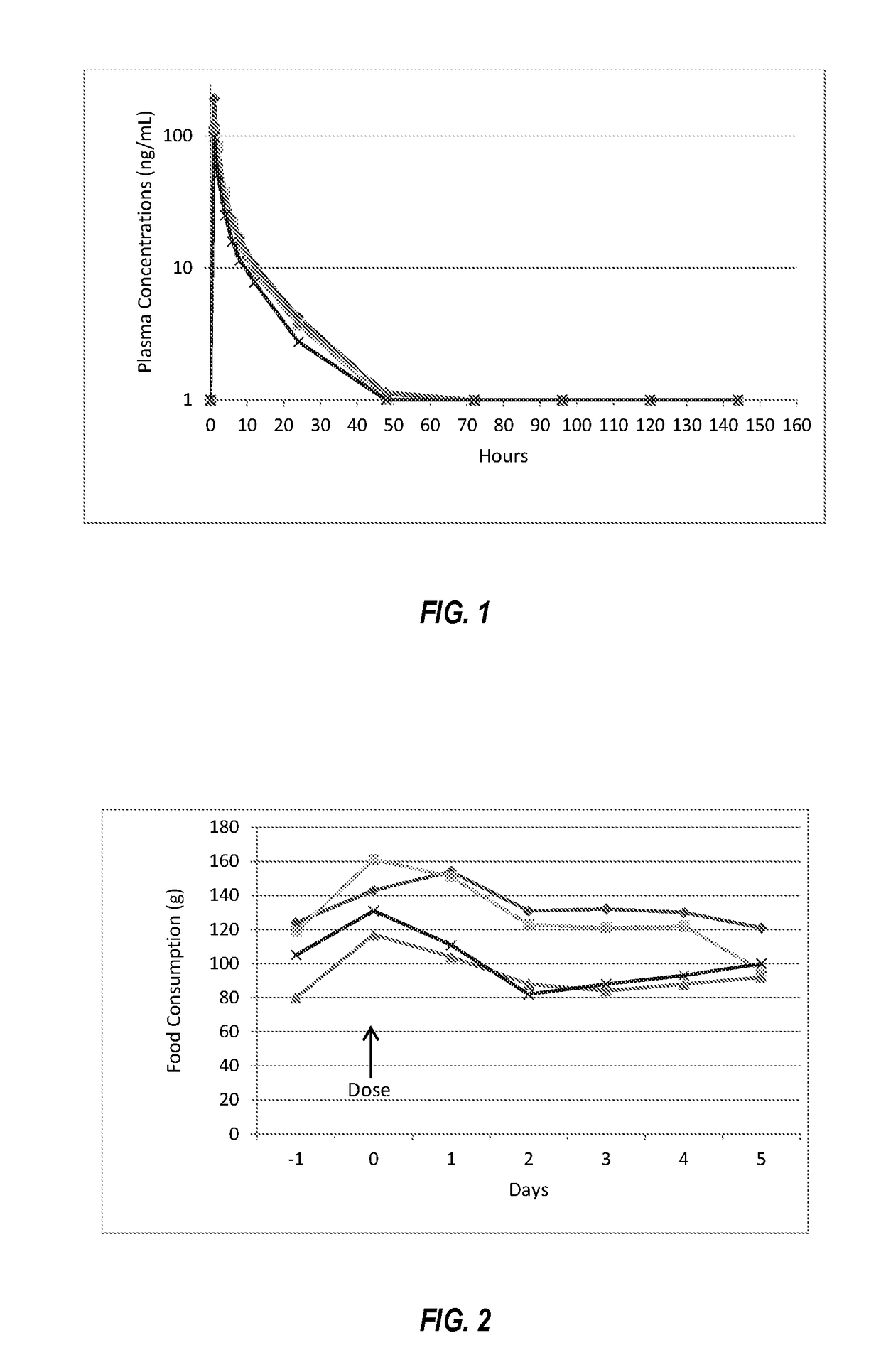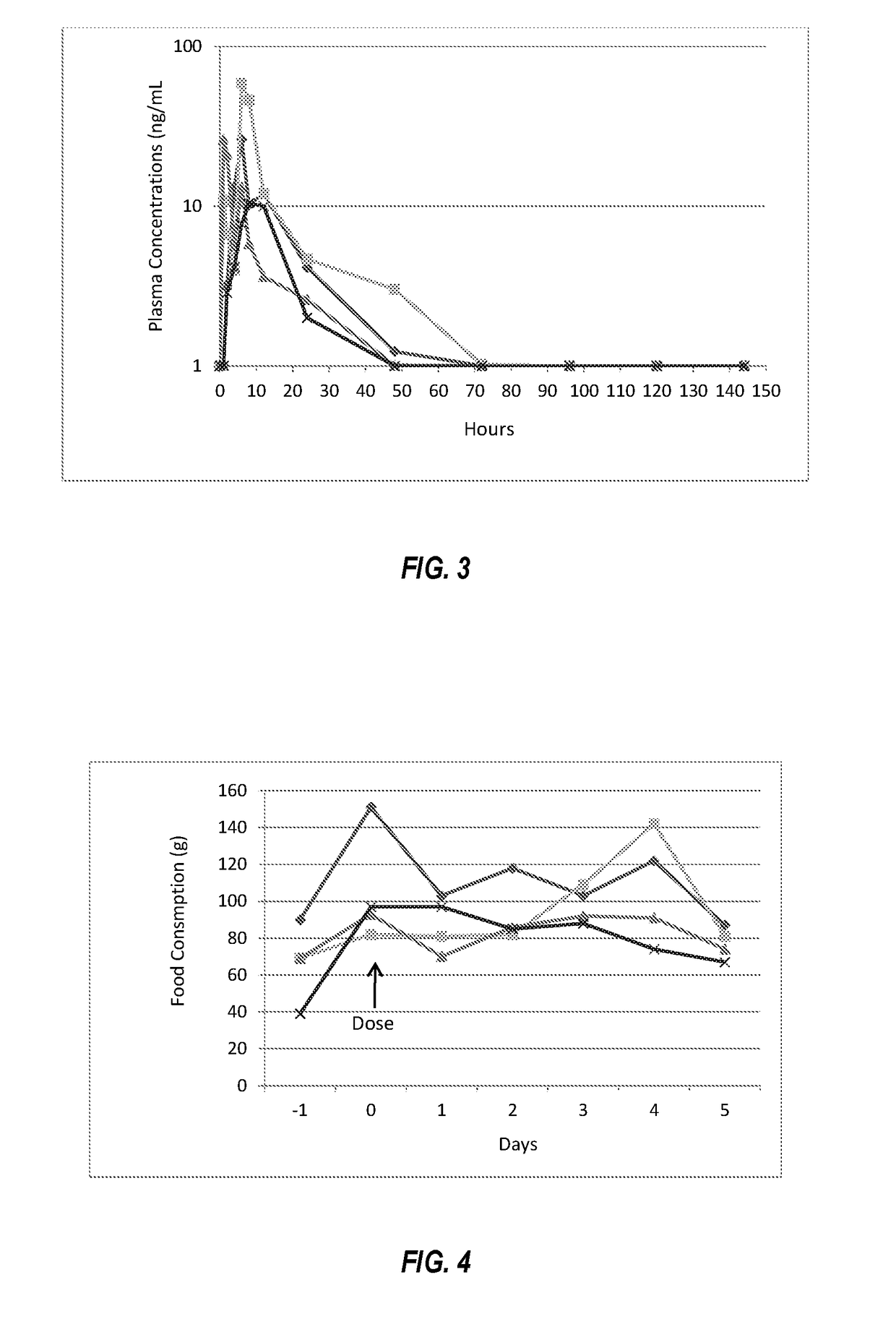Stimulation of appetite and treatment of anorexia in dogs and cats
a technology for stimulating appetite and anorexia in dogs and cats, which is applied in the field of veterinary medicine, can solve the problems of body weight loss, unwillingness to eat, and predisposing the animal to serious or fatal liver failure, so as to improve the stability of mirtazapine, increase the transdermal absorption, and enhance the effect of mirtazapine transdermal absorption
- Summary
- Abstract
- Description
- Claims
- Application Information
AI Technical Summary
Benefits of technology
Problems solved by technology
Method used
Image
Examples
example 1
tion of Therapeutic Efficacy of Oral Mirtazapine for the Stimulation of Appetite in Cats
[0066]A measured portion of a 45 mg commercial tablet (Remeron®) of mirtazapine was prepared by cutting and weighing and administered orally to four adult cats at a dosage of 0.5 mg / kg. In this demonstration, venous blood samples were taken at measured intervals to quantify the amount of mirtazapine in the plasma. Food consumption and activity were measured. The cats remained active and demonstrated no adverse effects from the treatment. Plasma concentrations of mirtazapine following oral dosing are summarized in FIG. 1. Peak plasma concentrations of mirtazapine were in the range of 50 to 150 ng / mL (mean 131), the peak concentration occurred at 1 to 2 hours after dosing, the total drug exposure as measured as area under the curve (“AUC”) was 250 to 750 (mean 507) h*ng / mL, and the half-life was 10 hours. Food consumption during the study was determined by weight of food consumed, and is shown in F...
example 2
tion of Variable Therapeutic Efficacy of a Topical (Transdermal) Commercially Available Compounded Formulation of Mirtazapine for the Stimulation of Appetite in Cats
[0067]A measured amount of a commercially available compounded mirtazapine ointment (Wedgewood Pharmacy) to deliver a dosage of 0.5 mg / kg was applied onto the skin of the inner (anterior) surface of the ear flap (pinna) of four cats, using the manufacturer's applicator and instructions (available in video form at www.youtube.com / watch?v=1R6CE5-WKQo).
[0068]The ointment was rubbed onto the surface of the pinna. Venous blood samples were taken at measured intervals to quantify the amount of mirtazapine in the plasma. Food consumption and activity were measured. The cats remained active and demonstrated no adverse effects from the treatment. Plasma concentrations of mirtazapine following topical dosing are summarized in FIG. 3. Peak plasma concentrations of mirtazapine were in the range of 10 to 50 ng / mL (mean 30 ng / mL), the...
example 3
tion of Therapeutic Efficacy Using Ointments for Topical (Transdermal) Administration to Stimulate Appetite in Cats
[0069]Sets of ointment excipients believed to be compatible with the present objectives were prepared and assessed for performance in certain methods provided herein. A variety of formulations were assessed.
[0070]In vivo testing of the formulations typically involved applying a measured amount of the ointment test formulation to deliver a dosage of 1.0 mg / kg to the skin of the inner (anterior) surface of the animal's ear flap (pinna). Unless otherwise indicated, four cats were tested for each formulation. The indicated amount of the transdermal ointment was rubbed onto the surface of the pinna by hand. The drug was absorbed through the skin into the systemic circulation. Venous blood samples were taken at measured intervals to quantify the concentration of mirtazapine in the animal's plasma. Appetite and activity were also measured in the treated animals. In all tests f...
PUM
| Property | Measurement | Unit |
|---|---|---|
| volume | aaaaa | aaaaa |
| volume | aaaaa | aaaaa |
| concentration | aaaaa | aaaaa |
Abstract
Description
Claims
Application Information
 Login to View More
Login to View More - R&D
- Intellectual Property
- Life Sciences
- Materials
- Tech Scout
- Unparalleled Data Quality
- Higher Quality Content
- 60% Fewer Hallucinations
Browse by: Latest US Patents, China's latest patents, Technical Efficacy Thesaurus, Application Domain, Technology Topic, Popular Technical Reports.
© 2025 PatSnap. All rights reserved.Legal|Privacy policy|Modern Slavery Act Transparency Statement|Sitemap|About US| Contact US: help@patsnap.com



